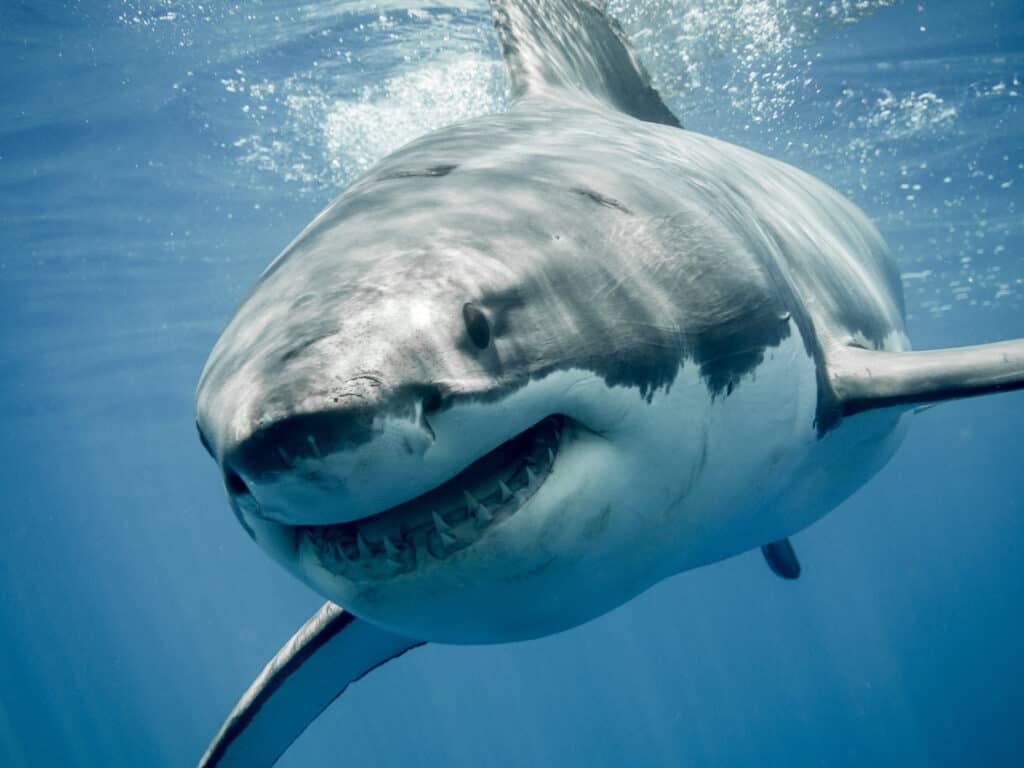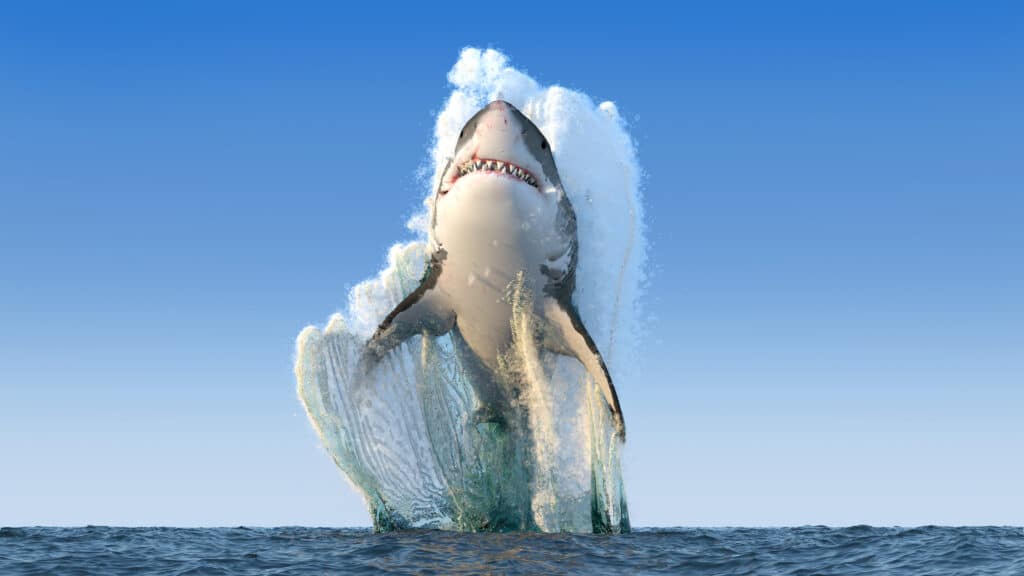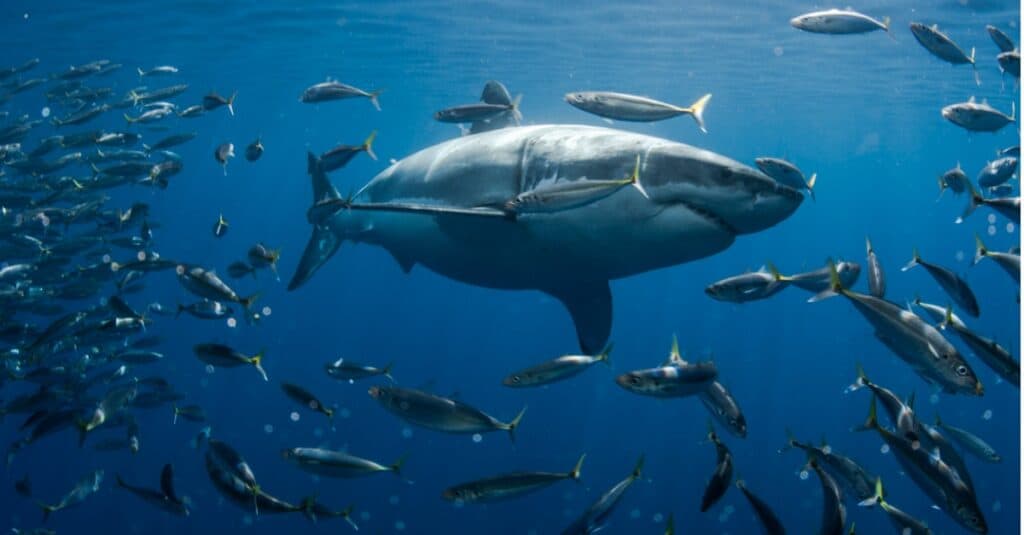Key Points:
- There are fewer than 3,500 great white sharks remaining worldwide and they are currently decreasing in number.
- The International Union for the Conservation of Nature classifies great white sharks as vulnerable to extinction mainly due to overfishing. Humans hunt great whites for trophies, and their meat, teeth and fins, with shark fin soup a delicacy in some parts of the world.
- Great whites are essential members of their ecosystems. As top predators, they stop fish populations from exploding by culling numbers of large fish, reducing the danger of wiping out smaller fish and consequently keeping reefs systems alive.
Have you ever gone swimming in the ocean and felt something brush against your leg? Chances are it was just seaweed or a harmless fish. But the first thing that jumps to mind is a nasty, 20-foot-long great white shark. For decades, movie producers have scared us with gruesome tails of man-eating great whites. But is there any truth to this? And how many great white sharks are left in the world? Read on to find this out and much more!
Where Are Great White Sharks Found?
The scientific name for great white sharks is Carcharodon carcharias. They belong to the family Lamnidae, which comprises a group of mackerel sharks. The remarkable size and speed of these fish make them efficient, dominant predators.
Great white sharks live in temperate and tropical coastal waters. Populations tend to be concentrated along the coasts of South Africa, North Atlantic, North Pacific, Australia, and New Zealand. There are also populations around Guadalupe Island and Hawaii.
Many sharks migrate yearly to the Pacific Gyre to feed. Unfortunately, this is also the site of the Great Pacific Garbage Patch. From this “garbage vortex,” sharks may ingest harmful plastics that cause injury, illness, or death.
Great White Shark Appearance

Great white sharks have torpedo-shaped bodies that are sleek and powerful.
©Ramon Carretero/Shutterstock.com
As the largest predatory fish in the world, great white sharks are well-adapted to hunting prey. Their torpedo-shaped bodies are sleek and powerful, able to accelerate from a low cruising speed to a sudden flurry of activity. Precisely shaped tail and pectoral fins give them both speed and buoyancy. Their ultra-tough gray skin resists tears and punctures while helping them camouflage against the sea floor. White underbellies give the great white its name.
Great white females tend to be bigger than males, reaching up to 20 feet (6.1 meters) in length. They can weigh as much as 5,000 pounds.
Great White Shark Teeth

Great white sharks sport 300 serrated teeth in five rows.
The most fearsome part of a great white shark is indisputably its teeth. Great whites have more than 300 razor-sharp, serrated, triangular teeth arranged in five rows. Each tooth is about six centimeters long. Teeth like these are made for ripping flesh, which the shark swallows without chewing. With this, anything looking in would be absolutely terrified!
The bite force of great white sharks is the greatest on earth, though not the greatest relative to body mass. Stephen Wroe, an Australian scientist, created a 3D computer model to estimate a great white’s jaw strength. The result was a bite force of 4,000 PSI or 1.8 tons!
The bite force of the great white shark shouldn’t be as great as it is. Their jaws are made of cartilage, not bone, and therefore are more elastic. In most animals, this significantly affects the bite force. In great whites, however, the effect is minimal.
Great White Shark Diet and Predators

Great white sharks are carnivores and apex predators. As they sit at the very top of the food chain, they have their pick of most life forms beneath them. Their favorite preys are seals, including elephant seals and harbor seals. They will also eat sea lions, dolphins, porpoises, and other sharks. Large fish like tuna and mackerel are acceptable if they can get them. Sometimes, they will scavenge meat from whale carcasses.
Most creatures will not dare to attack a great white shark. However, there are a couple of notable exceptions. Killer whales (orcas) are even bigger and fiercer and will eat great whites on occasion. Other sharks pose a threat from time to time. Also, humans hunt sharks for trophies and their fins.
The World’s Biggest Great White Shark
A female shark named Deep Blue is the world’s biggest great white on record. Scientists discovered her in the 1990s but did not catch her on video until 2013. Imprecise measurements put her at 21 feet in length with a weight of over 5,000 pounds. As great whites live between 40-70 years, she may be around for many years to come.
Are Great White Sharks Dangerous?

Only five to 10 unprovoked great white shark attacks occur worldwide every year.
©Alexyz3d/Shutterstock.com
Great white sharks are dangerous predators both to other sea life and to humans. Although shark attacks are relatively rare, they can cause serious damage.
On average, 72 unprovoked shark attacks occur every year. Out of these, great whites are responsible for approximately 5-10. Taking into account the vast numbers of people swimming in the ocean every year, it is highly unlikely that a great white shark will attack any given individual.
Florida is a shark attack hotspot, with more attacks there per year than any other area in the world. New Smyrna Beach, in particular, has the largest number of shark attacks on record. Other risky areas include Dyer Island in South Africa, New South Wales in Australia, and Hawaii.
Why do great white sharks attack? Often, they mistake the kicking legs and flailing arms of swimmers for sea lions, seals, or fish. Sometimes, it’s a matter of simple curiosity. Additionally, if blood leaks into the water, a shark will follow it and possibly try to bite the source.
Statistics show that shark attacks are on the rise. This is not due to greater shark ferocity, however. An increasing human population and more swimmers on beaches are likely responsible for the rise in shark attacks.
Ways to avoid being attacked by a shark include:
- Remaining in a group
- Staying close to shore
- Staying out of the water if bleeding
- Not swimming at dawn, dusk, or nighttime when visibility is lower, and sharks are more active.
Number of Great White Sharks Left in the World

There are fewer than 3,500 great white sharks left in the world.
©iStock.com/atese
There are fewer than 3,500 great white sharks left in the world. They are currently decreasing in number worldwide. This is having a widespread effect on ocean ecosystems as apex predators become more and more scarce.
Are Great White Sharks Endangered?
The International Union for the Conservation of Nature (IUCN) classifies great white sharks as vulnerable to extinction. Overfishing is the main cause. Humans often hunt great whites for trophies as part of sport fishing. Others hunt great whites for their meat, fins, and teeth. Shark fin soup is a delicacy in some parts of the world.
Sometimes, shark deaths are accidental. Gill nets and mesh swimming barriers may catch passing sharks, which are then unable to get themselves loose.
Many people think the oceans would be better off without great white sharks. However, this is not the case! Great whites are essential members of their ecosystems. As top predators, they keep fish populations from exploding by culling the numbers of large fish. If not kept in check, these large fish would increase in number to the point of wiping out the populations of smaller fish. Some of these small fish keep coral reefs clean and disease-free. Without them, algae would soon take over the reefs and exacerbate their decline.
The next time you’re in the ocean and sneak a look around for a great white, just remember: the ocean is their home, not ours! Given how many great white sharks are left in the world, they are unlikely to bite you.
The photo featured at the top of this post is © Martin Prochazkacz/Shutterstock.com
Thank you for reading! Have some feedback for us? Contact the AZ Animals editorial team.






